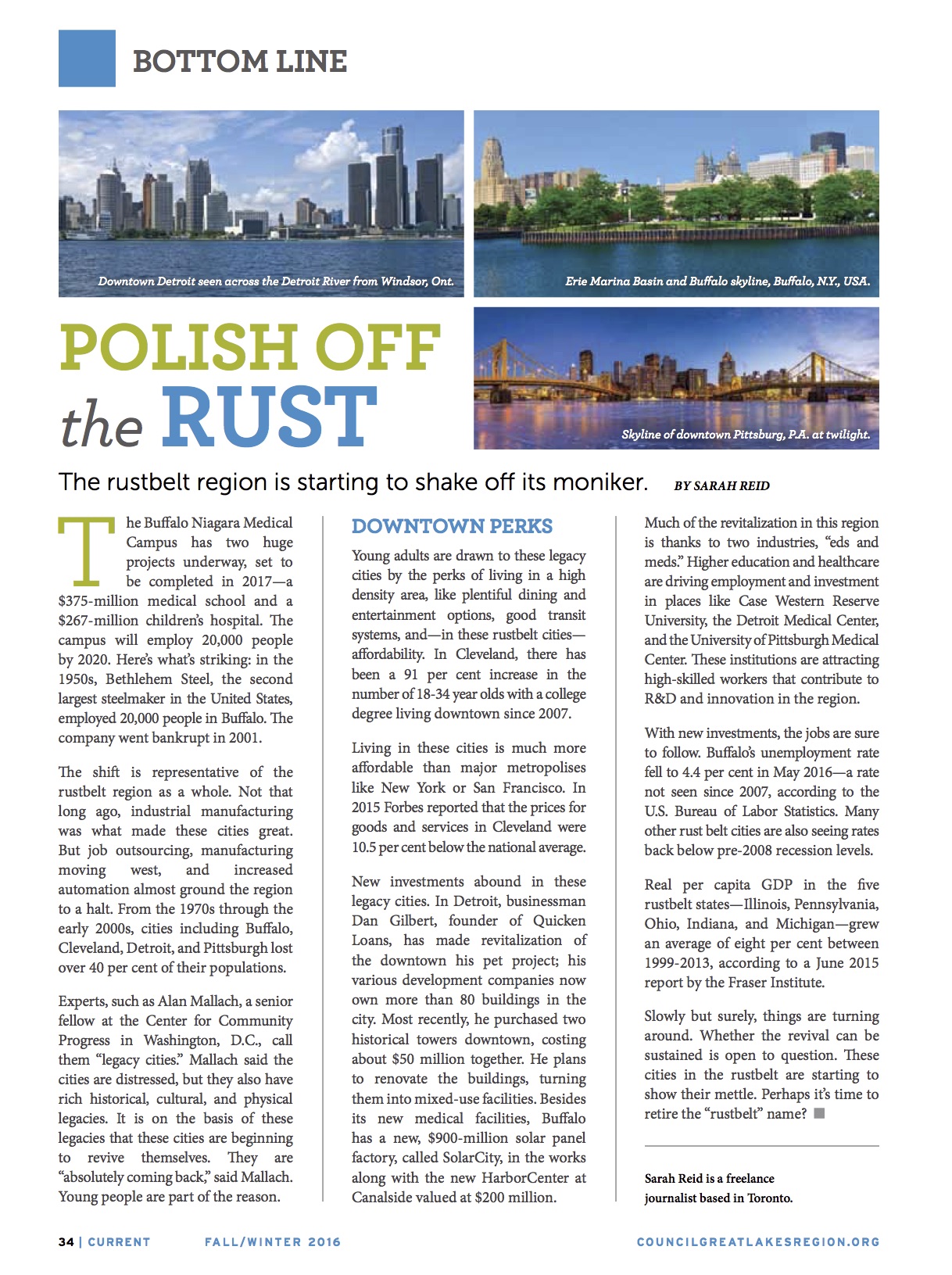Polish off the rust
/As published in Current Magazine:
The Buffalo Niagara Medical Campus has two huge projects underway, set to be completed in 2017: a $375 million medical school, and a $267 million children’s hospital. The campus will employ 20,000 people by 2020. Here’s what’s striking: in the 1950s, Bethlehem Steel, the second largest steelmaker in the United States, employed 20,000 people in Buffalo. The company went bankrupt in 2001.
The shift is representative of the rustbelt region as a whole. Not that long ago, industrial manufacturing was what made these cities great. But job outsourcing, manufacturing moving west, and increased automation almost ground the region to a halt. From the 1970s through the early 2000s, cities including Buffalo, Cleveland, Detroit and Pittsburgh lost over 40 per cent of their populations.
Experts, such as Alan Mallach, a senior fellow at the Center for Community Progress in Washington, D.C., call them “legacy” cities. The cities are distressed, he says, but they also have rich historical, cultural, physical legacies. And it is on the basis of these legacies that these cities are beginning to revive themselves. They are “absolutely coming back,” says Mr. Mallach. Young people are part of the reason.
Downtown Perks
Young adults are drawn to these legacy cities by the perks of living in a high density area, like plentiful dining and entertainment options, good transit systems, and -- in these rustbelt cities – affordability. In Cleveland, there has been a 91 per cent increase in the number of 18-34 year olds with a college degree living downtown since 2007.
Living in these cities is much more affordable than major metropolises like New York or San Francisco. In 2015 Forbes reported that the prices for goods and services in Cleveland were 10.5 per cent below the national average.
New investments abound in these legacy cities. In Detroit, businessman Dan Gilbert, founder of Quicken Loans, has made revitalization of the downtown his pet project; his various development companies now own more than 80 buildings in the city. Most recently, he purchased two historical towers downtown, costing about $50 million together. He plans to renovate the buildings, turning them into mixed-use facilities. Besides its new medical facilities, Buffalo has a new, $900 million solar panel factory, called SolarCity, in the works, along with a new facility called HarborCenter at Canalside, valued at $200 million.
Much of the revitalization in this region is thanks to two industries: “eds and meds.” Higher education and healthcare are driving employment and investment, in places like Case Western Reserve University, the Detroit Medical Center and the University of Pittsburgh Medical Center. These institutions are attracting high-skilled workers, that contribute to R&D and innovation in the region.
With new investments, the jobs are sure to follow. Buffalo’s unemployment rate fell to 4.4 per cent in May 2016 – a rate not seen since 2007, according to the U.S. Bureau of Labor Statistics. Many other rust belt cities are also seeing rates back below pre-2008 recession levels.
Real per capita GDP in the five rustbelt states – Illinois, Pennsylvania, Ohio, Indiana and Michigan – grew an average of 8 per cent between 1999-2013, according to a June 2015 report by the Fraser Institute.
Slowly but surely, things are turning around. Whether the revival can be sustained is open to question. These cities in the rustbelt are starting to show their mettle. Perhaps it’s time to retire the “rustbelt” name?
Sarah Reid is a freelance journalist based in Toronto.
